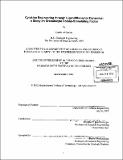| dc.contributor.advisor | Douglas A. Lauffenburger. | en_US |
| dc.contributor.author | Sarkar, Casim Ali, 1975- | en_US |
| dc.contributor.other | Massachusetts Institute of Technology. Dept. of Chemical Engineering. | en_US |
| dc.date.accessioned | 2005-06-02T16:11:19Z | |
| dc.date.available | 2005-06-02T16:11:19Z | |
| dc.date.copyright | 2002 | en_US |
| dc.date.issued | 2002 | en_US |
| dc.identifier.uri | http://hdl.handle.net/1721.1/17561 | |
| dc.description | Thesis (Ph. D.)--Massachusetts Institute of Technology, Dept. of Chemical Engineering, 2002. | en_US |
| dc.description | Vita. | en_US |
| dc.description | Includes bibliographical references. | en_US |
| dc.description.abstract | Granulocyte colony-stimulating factor (GCSF) is a cytokine of great clinical importance, with application to elevate neutrophil counts in cancer patients undergoing chemotherapy. GCSF binds to its specific receptor (GCSFR) on bone marrow precursor cells and generates intracellular signals that cause these cells to proliferate and differentiate into mature neutrophils. However, for such cytokines that act as agonists for cell-surface receptors, these complexes undergo trafficking processes that often attenuate the intracellular signals through internalization and degradation. Additionally for GCSF, the bloodstream neutrophils represent a further negative feedback mechanism that limits the potency of the drug, as they also express GCSFR and degrade the drug through receptor-mediated endocytosis. Using the GCSF/GCSFR system, we have developed an effective method for deconvoluting the effects of binding affinity on ligand potency, and this analysis successfully predicts the half-life ranking of combinatorially generated GCSF analogs in culture. Protein structural studies and equilibrium denaturation experiments unexpectedly revealed that GCSF becomes more stable as the pH decreases from 7 to 4 (coincident with the pH range experienced along the endocytic trafficking pathway); however, similar experiments performed on analogs from the deconvolution analysis were consistent with a proposed correlation between decreased structural stability at endosomal pH and enhanced ligand half-life. | en_US |
| dc.description.abstract | (cont.) We also propose a new method for the rational design of more effective analogs by identifying amino acid substitutions that should reduce receptor binding affinity in intracellular endosomal compartments to yield enhanced sorting to recycling and consequently longer lifetimes in extracellular medium. We successfully demonstrate this approach, which we term 'histidine switching,' for GCSF, employing computationally predicted histidine substitutions to switch protonation states between cell-surface and endosomal pH. Finally, we integrate a cell-level model of GCSF/GCSFR dynamics into an existing pharmacokinetic/pharmacodyamic model to elucidate the relationship between molecular and pharmacological properties of GCSF. The work presented here may provide general principles for cytokine design. | en_US |
| dc.description.statementofresponsibility | by Casim Ali Sarkar. | en_US |
| dc.format.extent | 172 p. | en_US |
| dc.format.extent | 7824549 bytes | |
| dc.format.extent | 7824357 bytes | |
| dc.format.mimetype | application/pdf | |
| dc.format.mimetype | application/pdf | |
| dc.language.iso | eng | en_US |
| dc.publisher | Massachusetts Institute of Technology | en_US |
| dc.rights | M.I.T. theses are protected by copyright. They may be viewed from this source for any purpose, but reproduction or distribution in any format is prohibited without written permission. See provided URL for inquiries about permission. | en_US |
| dc.rights.uri | http://dspace.mit.edu/handle/1721.1/7582 | |
| dc.subject | Chemical Engineering. | en_US |
| dc.title | Cytokine engineering through ligand/receptor dynamics : a study on granulocyte colony-simulating factor | en_US |
| dc.type | Thesis | en_US |
| dc.description.degree | Ph.D. | en_US |
| dc.contributor.department | Massachusetts Institute of Technology. Department of Chemical Engineering | |
| dc.identifier.oclc | 52298438 | en_US |
